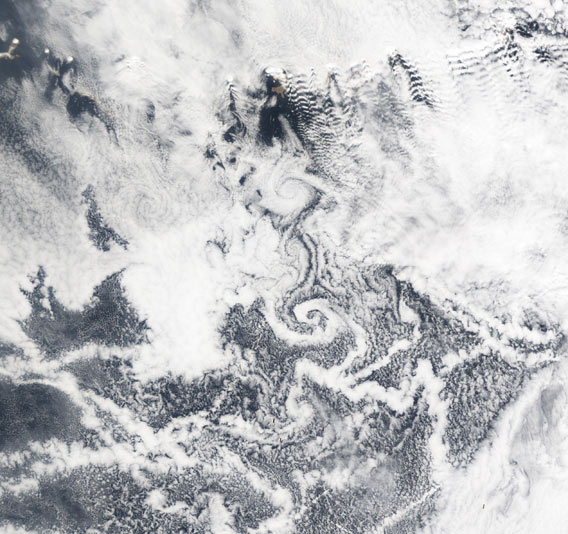Create a free profile to get unlimited access to exclusive videos, sweepstakes, and more!
The Tracks of Ships Are Written in the Sky

Hereâs something I didnât know happened: Under the right conditions, the exhaust from ships plying the ocean can form clouds, leaving tracks criss-crossing the sky.
This image, taken by NASAâs Earth-observing Terra satellite on Apr. 20, 2013, shows some of these long thin clouds (called ship tracks) in the Aleutian Islands off the coast of Alaska. Actually, thereâs quite a bit going on here, and the ship tracks are just one part.
The tracks themselves can be seen as the mostly linear clouds all over the bottom of the picture. What happens is that the ships emit aerosolsâtiny particlesâin their exhaust. Water vapor in the air condenses around the particles, forming tiny spheres of water: cloud droplets. As the ship moves, these trace its path like airplane contrails, and over time the ship tracks can have their shape bent by winds.
The curlicue in the lower center caught my eye, and I knew right away what it was: part of a von Kármán vortex, a spinning parcel of air downwind from an obstacle like an island. Sure enough, if you look above the vortex youâll find another, and then above that a tiny island, a patch of greenish-brown poking through a clear spot in the clouds. Well, tiny on this scale: Thatâs Tanaga Island, and itâs actually over 40 kilometers (24 miles) long! The whole image shown here is about 650 km (400 miles) acrossâroughly the size of my home state of Coloradoâand itâs only one part of an even bigger shot.
I was also drawn to the ripples to the east (right) of Tanaga, and it turns out those are not due to ships at all, but are still called âship wave cloudsâ! Thatâs because of their resemblance to the wake of a boat, and they form in a similar way. Winds blowing past volcanoes in the island chain whip around and over the peaks. As they do, they form that V-shape like foamy water off the bow of a ship (hence the name). As the air flows past, it also rises and falls like the ripples in a sheet. The air at the top of the ripples is cooler, and the water can condense to form clouds. At the troughs, the air is warmer and clearer. If the air were dry youâd never see those ripples, but the water vapor in them makes the pattern visible.
I am endlessly fascinated by clouds and the patterns they make. Iâm spoiled living in Boulder; the Rocky Mountains are upwind, and constantly sculpting the clouds into amazing shapes. But it also helps to have an eye in the sky, too, looking down on us and sending back amazing and beautiful pictures like this one.


























